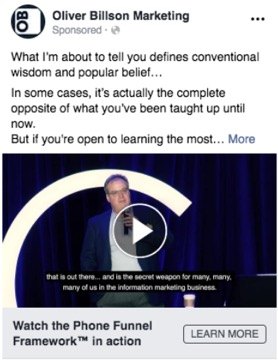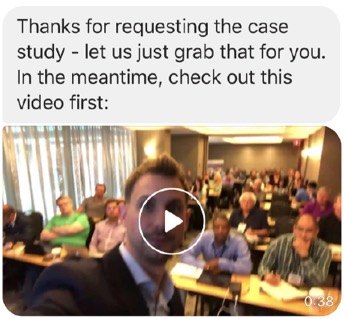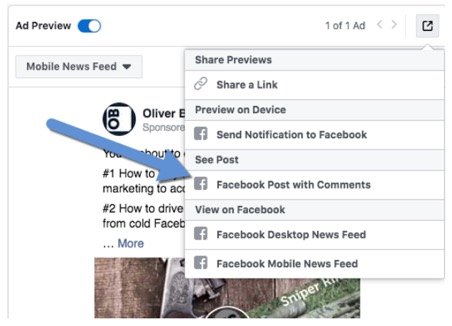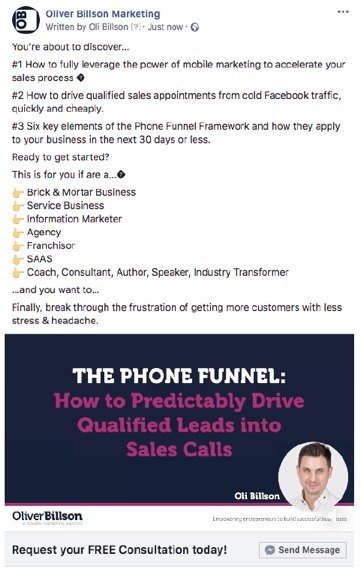Are sales calls a big part of your business?
Do you need to have a conversation with somebody before they buy?
If so, this Messenger Marketing funnel could be a game-changer for you.
A couple years ago, my agency, Oliver Billson Marketing, developed something called The Phone Funnel Framework. It got a lot of attention thanks to the amazing results it was generating for all sorts of different companies, including…
- Brick & mortar businesses
- Service businesses
- Information marketers
- Agencies
- Franchisors
- SaaS companies
- Coaches, consultants, authors, speakers
- And more
It’s been a really effective marketing funnel for years. And now, thanks to the coming of ManyChat and Messenger Marketing, it’s even better.
In this post I’m going to share with you the new and improved Phone Funnel Framework, which you can use to drive qualified sales appointments from cold Facebook traffic—quickly and cheaply.
First, let me start with a little overview of what the Phone Funnel Framework is and how it works.
What is the Phone Funnel Framework?
The Phone Funnel is a marketing funnel framework that I initially developed using a combination of Lead Ads and SMS (text) ads. The whole process worked something like this:
- Use Facebook Lead Ads to generate leads.
- Send them an SMS (text) message with a link to our Main Event Video (essentially sort of a video sales letter).
- At the end of the video, provide a call-to-action (CTA) to schedule a call.
And that’s the essence of it. It’s simple, and that simplicity is a big part of what makes the Phone Funnel Framework so effective. You don’t have to spend hours diagramming a mind-bogglingly complex framework. Instead it’s easy to put together, and it’s very modular if you need to shift things around.
That means it’s also easy to make adjustments and improvements if you find that one part of the funnel isn’t working as well as it should be.
Another secret to the Phone Funnel Framework is that it maintains a congruity between the response mechanism and the delivery mechanism. Instead of trying to send people back and forth from their phone to their computer and back again, we’re keeping people on the device where they first responded to our ad (their phone). And as much as possible, we’re even keeping them on the platform where they responded to us, which is Facebook.
And now that we’ve started using ManyChat to deliver our content through Messenger instead of SMS, the Phone Funnel Framework has become even MORE effective than ever.
So how does it work? I’m glad you asked.
The Phone Funnel Framework is made up of 5 primary steps. Let’s go through them now.
Step 1: Facebook Messenger Ad
The first step in the process is to get in front of the right audience, and what better way to do that than with Facebook ads?
In most cases you’re going to want to use the JSON growth tool inside of ManyChat, and create an ad with a Messenger objective.
Your goal here is to get people to engage with you on Messenger, subscribe to your ManyChat list, and watch a short video that you’ll deliver to them inside Messenger.
Here’s an example of what one of these ads might look like:

Now, what should you actually SAY in that ad?
To get the best success with the Phone Funnel Framework, I recommend coming up with 5 different ad angles. Each ad angle could be a different benefit your avatar wants, or a problem they’re facing.
And for each of those ad angles, you’ll want to test 4 different images. So that results in a total of 20 different ads, 5 angles with 4 images each.
Make sense?
And you’ll want to test all those ads on as many audiences as possible. Personally I think 30 is a good benchmark. If you can test all 20 ads on 30 different audiences, that will result in 600 separate ad+audience combinations. With that many ads running to that many different audiences, you’ll stand a very good chance of reaching your ideal avatar with the right messaging.
Step 2: Primer Video
After someone opts in to your ad, the first step of this process is what we call the Primer Video.
The purpose of this video is to pre-frame people for the Main Event Video that they’re about to watch. We’re “priming the pump,” so to speak, and reselling them on the value of watching that video.
If you can get people excited about the information they’re about to learn in the Main Event Video, that will really help to increase the engagement and consumption of your content.
Video Location
You should upload this video directly into ManyChat.
This way you’ll keep people inside the Messenger environment and make it easy for them to watch the video without going anywhere.
Here’s what it looks like when you do that:

As far as what we actually say in the Primer Video, that’s pretty straightforward. Simply follow this 5-step framework, which is basically an expanded version of the tried-and-true “Star, Story, Solution” formula.
1. Reinforce the Prior Positive Action
Start out by telling the person what a great decision they just made by requesting and watching this video. This will help build some goodwill, get them feeling good about themselves, and make them even more committed to finishing the rest of the video.
Example: Hey, thanks so much for clicking through to watch this case study video. You’ve made a great decision and I know you’re going to get a ton of value from this video.
2. Star: Who You Are
Briefly introduce yourself.
Example: My name is Oli Billson, owner and founder of the Oliver Billson Group.
3. Story: Your Origin
Now quickly explain why you’re qualified as an expert who can help them solve the problem they’re facing.
Example: For the past 12 years I’ve been helping business owners just like you to grow their businesses using direct marketing.
4. Solution: Pre-Frame
Next, tell the viewer what they’re going to discover in the Main Event Video. Keep it simple and be sure to include a big benefit that you know the viewer wants to achieve.
Example: What you’re about to discover is how you can use the Phone Funnel Framework to predictably drive qualified leads into sales appointments.
5. Call-to-Action
Now tell them what to do next! The CTA from your Primer Video is simply to click through to watch the Main Event Video.
Example: Just click the link below to watch the free case study video now.
Step 3: Main Event Video
Now we’ve come to the Main Event Video, which is the piece of content in this funnel that does most of the heavy lifting. And throughout this section, it’s important to keep in mind that the purpose of this video is to get leads to qualify themselves to take the next step.
Remember, you only want to talk to qualified leads here.
This video is significantly longer than the Primer Video—it should be about 15-45 minutes long. The format can be whatever you want—a recorded Keynote presentation, a face-to-camera video, or a combination of both.
Your call-to-action at the end of this video should be for the person to click through to schedule a call. (And if they don’t take that action, follow-up begins through Messenger.)
Video Location
Unlike the Primer Video, the Main Event Video won’t be uploaded directly into ManyChat. (For one thing, it will probably be over ManyChat’s 25 MB limit for uploads.)
Instead we’re going to basically host this video with a dark post. See, we want to keep people inside the Facebook platform. This is useful for several reasons:
- It reduces friction by keeping people on Facebook.
- You can add copy and a call-to-action button.
- You can retarget people based on video engagement.
- It allows you to leverage social proof by building up likes, shares, and comments.
This way we can host the video inside of Facebook, with its own unique URL that we can link to—but it won’t be discoverable by anyone except those who have already watched your Primer Video.
Make sense?
Here’s how to do it:
- Create a new Facebook Ads Campaign.
- Create an ad, and upload your Main Event Video.
- Use your ManyChat URL as the ad’s Destination URL.
- Publish your ad.
- Copy the URL of your Post ID.
- Unpublish your ad.
To complete step #5, just open the ad inside the Facebook Ads Editor. Click to “Edit” the ad, then click “Facebook Post with Comments” right here:

That will open the post in a new tab. Just copy the URL of that tab and use it as the URL for your Main Event Video.
So we’re creating an ad, but we’re not actually running it as an ad. We’re just using the ad as a repository for that Main Event Video.
And it will look just like a Facebook ad, like this:

Now, what’s the structure for this video?
This one is more complicated—it has 12 steps instead of 5. And like I mentioned earlier, it will be significantly longer than the Primer Video (15-45 minutes is the sweet spot).
Here are the 12 points you’ll want to hit in this video, in order:
1. Attention-Grabbing Title
This one is a no-brainer, but it’s so important that I’m pointing it out here. Make sure your headline grabs attention and promises a desirable benefit. Notice how, on the screenshot above, this headline makes up the video’s thumbnail image.
2. What You’ll Discover
At this point, early in the video, you need to hook the viewer as fast as you can. So give them a quick idea of what they’re going to learn. This is sort of a teaser that will help make sure the viewer sticks around to watch the entire thing.
3. Who Is This For?
Call out your audience. This will help grab your target viewer’s attention and make them perk up, because they’ll know you’re talking directly to them.
4. Imagine If…
This is where you future-pace the benefit. This is most effective if you phrase it from the viewer’s point of view, using a present-tense voice. For example:
“Imagine you have a way to generate qualified sales appointments on demand, anytime you want…”
This gets them actually visualizing the benefits, which is a really powerful technique.
5. Why Listen To Me? My Story
Before people will listen to you, they need to be able to trust you. So state your credentials and successes, so people will feel confident that you know what you’re talking about.
One of the most effective ways to do this is with a short story. For example, I like to tell people that I started my first business at age 15, that I’m an international franchisor, the founder of NextLevelBusiness.com, and that I scaled six separate companies to the 7-figure level.
It builds credibility. Very important step.
6. Why Am I Teaching You This?
Let people know why you’re teaching this content. It’s helpful to insert a personal reason here—maybe you were in their shoes and you can empathize with the situation they’re in. Or maybe you just derive immense satisfaction from helping business owners overcome their problems.
7. You’ll Learn 1-4 Chunks
This is the longest step in the video. It’s where you actually teach the viewer what you promised to give them. You don’t want this to be too long; 3 chunks of useful content is about right.
8. Summary
Briefly summarize what you taught them.
9. You Have Two Choices…
Tell the viewer that they really only have 2 choices: they can go out and try to do this on their own, or they can take the natural step to have a conversation with you about whatever it is you’ve got to offer.
10. Who This Is NOT For
You already said who this IS for; now tell them who it’s NOT for. This will help to filter out unqualified visitors, yes, but more importantly it will reinforce to your true target audience that this is something that applies to them. The other benefit of saying who this is NOT for is that you come across as being more exclusive, and therefore your offer appears more valuable.
11. What You’re Getting
Tell them what they’re going to get when they click the call-to-action button to schedule their call. The more unique and desirable the benefits you can deliver, the better.
12. Click The Link
Finally comes your call-to-action: you want them to click the button on your video post to schedule a call with you.
Step 4: Scheduled Call
The next step is simple. Your viewer has just clicked your CTA button to schedule a call—so give them a way to do just that!
And for this part of the Phone Funnel Framework, we follow a two-step process:
1. Get the user to schedule a time & date for their call.
First things first, we like to schedule the call ASAP. Get that commitment made. And for this, we use a tool called ScheduleOnce.
The cool thing about ScheduleOnce is that we can connect it to ManyChat using Zapier. We use that integration to remove someone from our ManyChat follow-up sequence once they’ve scheduled their call (so they won’t continue to receive follow-up messages urging them to schedule).
2. Qualify the user.
We do this immediately after the call is scheduled, on the very next thank-you page. Here we’ll ask for information like:
- Their current situation
- Their desired situation
- What’s stopping them
- What their investment level is
And so on.
We use the investment level responses here to qualify prospects. If someone fills out this form stating that they don’t have any money, we’ll disqualify that person, cancel their phone call, and send them a few free resources instead.
Everyone else is qualified, so we leave scheduled and let the sales people take it over from there!
Another helpful idea at this point is to have your salespeople record a short personalized introduction video. Then you can send each prospect a video of the salesperson they’re about to speak with prior to their call.
Step 5: Nurture Follow-Up
At this point, we’ve gone through the entirety of the Phone Funnel Framework. From beginning ad (step 1) to the final sales call with a qualified prospect (step 4).
So what could be left for step 5?
Well, even though steps 1-4 can take prospects all the way through this process from beginning to end, there are always going to be a lot of people who fall out of the funnel somewhere along the way. So step 5 in the Phone Funnel Framework is where we follow up with all those people who made it only part way through the process.
And when we think about using nurture sequences for this framework, there are 2 main audiences we need to focus on:
People Who Clicked on Your Ad, But Need to Watch the Main Event Video
Remember, people cannot schedule their call until they watch your Main Event Video first. So for anyone who has entered your campaign but hasn’t yet watched that video, your goal needs to be getting them back to that video and watching it.
What we do in this situation is create 3 content videos that all push people back to that Main Event Video. And you can deliver these videos right inside of ManyChat if you’re inside the 24-hour message window, just like you did for the Primer Video. If your message is outside the window, you can send an SMS or email follow-up to encourage people to come back into your ManyChat bot.
For these 3 content videos, we use a simple framework:
- State a problem they’re facing.
- Provide the solution.
- Give them a call-to-action.
When you’re creating these videos, remember that the person has not yet seen the Main Event Video—so you can’t really allude to anything that’s in that video yet. Instead, you should go back to the main problem, frustration, or pain point in your initial ad that they responded to.
And at the end of each video, your call-to-action is really simple: go watch the Main Event Video.
People Who Saw the Main Event Video, But Need to Schedule Their Call
This is probably the most important audience to focus on, because they’re this close to actually scheduling their call. They’ve already watched the Main Event Video, they’ve already engaged, so you know they’re interested. You just need to figure out what’s stopping them from taking the next step, and overcome those objections.
The best way I’ve found to overcome objections like these is with a series of objection-handling videos. I recommend a series of 6 videos, each of which is created to overcome a different objection.
I like to create 3 FAQ videos and 3 SAQ videos.
You know FAQs are frequently asked questions, right? Well SAQs are questions people should be asking. These are the things people aren’t thinking about that they should be thinking about in order to book a call with you.
And once again, you can deliver these using ManyChat, whether it’s an SMS, email, or Messenger conversation. This is the best way I’ve found of addressing the specific objections that are holding people back from taking that next step and scheduling a call with you.
And that, in a nutshell, is how we handle our follow-up nurture sequences. Of course, anyone who entered your campaign but never converted should be put in a long-term nurture sequence.
What Results Should You Expect
There you have it, guys, the Phone Funnel Framework with a ManyChat twist. This is a marketing funnel that worked phenomenally well even BEFORE the advent of Messenger Marketing.
A few quick examples:
- One business spent $102,099.76 on this and generated 4,282 appointments—for a cost per appointment of $23.84. They ended up generating $718,033.44 in revenue, which is an ROAS of 7.03.
- Another business spent $90,338.85 and got 12,495 leads for a cost per lead of $7.23. They generated a total of $863,260 in revenue, for a ROAS of 9.56.
And since you can use ManyChat to deliver your content videos inside of Messenger, this framework is even more effective.
So if your business requires that you have a conversation with people before they buy, I really recommend you put this in action. It’s worked before and I know it will work for you, too.
Create a ManyChat bot today. It’s free to get started.

Oli’s superpower lies in strategizing and implementing cutting edge, conversion led, money-making sales and marketing funnels. Unlike a lot of marketers, it’s safe to say he makes more money actually practicing what he preaches, then teaching it! After starting his own business at the age of 15, Oli’s portfolio now spans four incredibly successful businesses, including Information Marketing, Training and Coaching, Bricks and Mortar businesses, and his widely sought after ‘Done For You’ Marketing business, as well as being an internationally recognized Franchisor. When he fancies it, Oli also spends time as a Consultant to many other well-known entrepreneurs and business growth experts. In recent years he’s been the Mastermind behind many big launches and event promotions for other Marketers, helping them grow and automate their businesses












